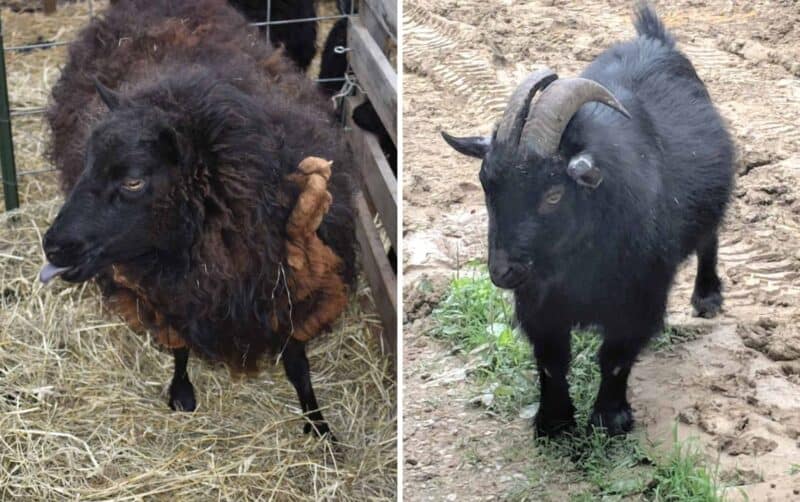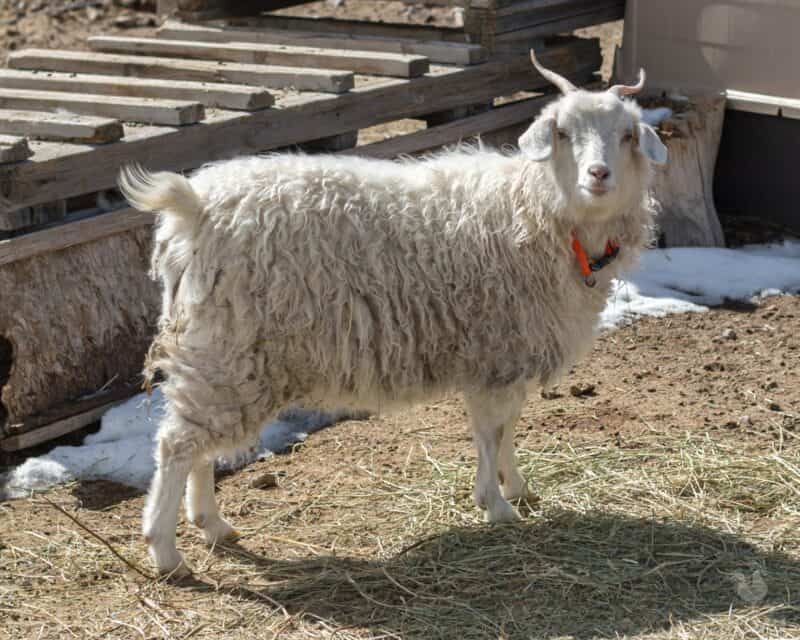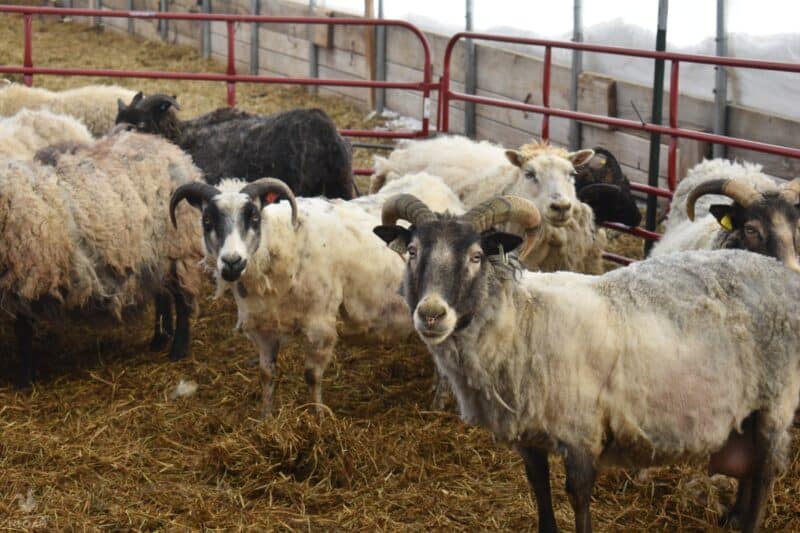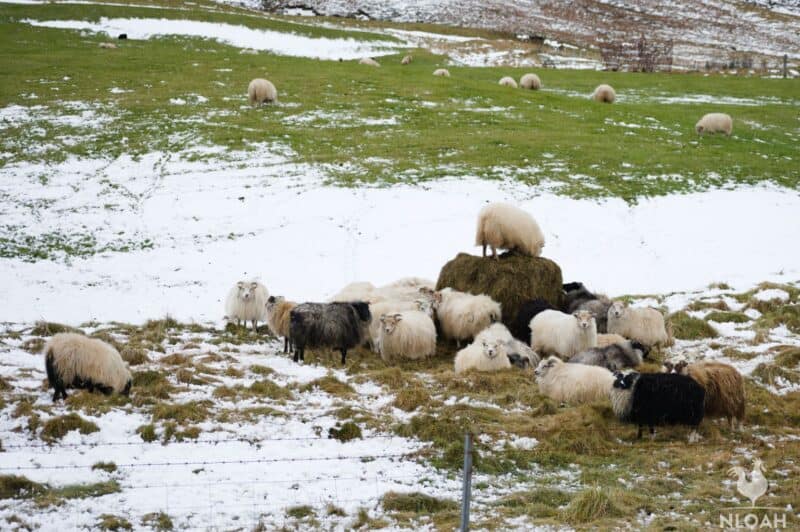When it comes to most livestock species, you’ll rarely have trouble telling them apart. Sure, without a little homework and working knowledge, it’s difficult to tell different breeds apart, but nobody gets pigs and horses mixed up. However, when it comes to sheep and goats, it can be really easy to confuse them!

They both have the same sort of diet, the same body plan, and are about the same size. They also both have those weird rectangular pupils in their eyes. The sounds they make are even similar!
Obviously, this won’t be an issue for you if you only have one or the other. But if you have both, or just want to sound like a pro when talking to other homesteaders, it pays to be able to identify them on sight.
Keep reading, and I’ll be telling you about eight ways to tell sheep and goats apart in this article.
Look at the Upper Lip, First
One of the best and most reliable ways to tell sheep and goats apart is to look at the upper lip. Their faces otherwise, for the most part, look quite similar, but there’s one feature that will always betray the difference, and that is the presence of a separation in the lip directly beneath the nose.
This is called a philtrum. Sheep have it; goats don’t. Note that this isn’t the crease that is just below their nostrils, but an actual notch in the lip itself. This gives sheep an appearance that vaguely looks like pursed lips, whereas goats’ lips look like a straight line when at rest.
Check the Tails
Another highly reliable indicator to tell the two apart is their tails, and this method is especially quick and easy even at a distance. Most goats have tails that point upward in a slight curve or angle when at rest – assuming they aren’t frightened, anxious, injured, or sick. The tails of sheep hang downward.

Note that even if a sheep’s tail is docked, or cut back, for hygiene reasons, it will still hang down after the procedure. So if you see a proud tail, chances are it’s a goat!
Coat Differences
One of the most immediate differences between goats and sheep is the nature of their coat. The vast majority of sheep breeds have a wool coat, which tends to take on a curly, layered, or matted appearance, whereas goats have hair.
Accordingly, sheep will require shearing at least every year in order to keep their wool under control, or else they will grow thicker and thicker over time.
Goats, on the other hand, shed naturally and don’t need a trip to the barber like sheep do. Goats also tend to have beards, long tufts, or clumps of hair under their chin and along the jowls on the neck.
Size and Build
Most folks I’ve talked to, those that don’t know a lot about livestock, have an image in their mind that sheep are simply a lot bigger than goats. This isn’t true going off averages and not a useful rule of thumb.
On average, goats and sheep tend to be about the same size, although there are more miniature breeds of goat than sheep, like Pygmies, Nigerian Dwarfs, and Mini Myotonics.
The average for goats and sheep is about 120 to 150 pounds, and standing about 24 inches tall at the shoulder. Still, sheep tend to be stockier and put on more fat compared to goats, so they often look much bulkier, especially in conjunction with their wool.
Goats, broadly, have a leaner and more athletic appearance.

Sheep Horns Are Usually Thick and Curvy
Another disappointment is that you can’t depend on the presence or absence of horns to help you tell these two species apart. Both can have horns; there are breeds within both species that may or may not feature horns depending on their lineage, and both breeds can have their horns disbudded or removed later in life.
Even more calls for confusion, males and females alike, of those species, can have horns of their own though as usual males tend to have horns that are larger and thicker.
That’s also a good guideline for telling these two apart: sheep tend to have horns that are thicker, meaning greater circumference, which also curve, curl, or loop back on themselves. Goat horns are narrow and more spike-like and tend to be only gently curving or straight.
Large and elaborate curly horns belong to sheep!
Foraging Behavior
Both sheep and goats are thought of as lawn-mowing animals, meaning they’ll just walk to and fro on your property eating nothing but grass, but this is an error when it comes to goats.
Goats, strictly speaking, are browsers, not grazers. This means they tend to roam around taking the best bits from various plants, including stuff that is up above the surface. Sheep are true grazers, eating lots of plants and grass that grow right at surface level or only slightly above it.
If you’re watching both species out in a pasture, goats will have their heads up when eating far more often, whereas sheep tend to have their heads down pretty much at all times when eating.

Flock/Herd Behavior
For the most significant difference between these two species is in regards to their social behavior. Sheep are true flocking animals, whereas goats exist in a herd structure.
There is considerable overlap in these two social structures, but many differences also…
Sheep flock, usually when their numbers are between 4 and 6. They prefer to be very close to each other at all times, and a flock will follow a leader without deviation except in cases of accident or when they’re left no other choice.
Sheep that are separated from their peers for any length of time will quickly become anxious and then stressed. Flock sizes for sheep can also be quite large, averaging around 50 and sometimes exceeding that number considerably.
Goats, on the other hand, like to stick together but they are far more comfortable exploring, roaming, and separating from each other over a larger area though they tend to come together for sleeping or in times of danger or extreme cold.
Goats are like sheep in that they need the company of other goats to be healthy and well-adjusted, but even one or just two other goats are enough to satisfy this social requirement. As numbers grow, herds will split apart into groups of between 15 and 20 adults.
A good baseline for telling goats and sheep apart at a distance is how closely they stick to each other: sheep will move around in closer, looking like a big clot at a distance. Goats will be more spread out even if they are moving together.
Smell
The last way to tell sheep and goats apart on our list, but certainly not the least, is with your nose!
Males of both species have scent glands that produce a distinct and unpleasant aroma, or musk. Male sheep, or rams, are a little fragrant at all times and get a bit pungent during mating season, but it isn’t too bad.
Male goats, called bucks or billies, on the other hand, are outrageously smelly at pretty much all times and eye-wateringly nasty during the mating season.
It’s something that they say you’ll get used to if you own goats long enough, but speaking for myself, I never did and eventually got rid of all of my males. Male sheep, in sharp contrast, are quite tolerable.
Note that castrating a male goat will keep him from getting musky and stinky, so keep that in mind if you’re trying to use aroma alone to make the determination. If he’s not intact, you can’t count on this!

Tom has lived and worked on farms and homesteads from the Carolinas to Kentucky and beyond. He is passionate about helping people prepare for tough times by embracing lifestyles of self-sufficiency.
